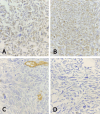Advanced, Recurrent Malignant Phyllodes Tumor With Malignant Heterologous Osteoid Differentiation Coexisting With Fibroadenoma in a 17-Year-Old Female Nigerian: A Case Report
- PMID: 40385760
- PMCID: PMC12085154
- DOI: 10.7759/cureus.82448
Advanced, Recurrent Malignant Phyllodes Tumor With Malignant Heterologous Osteoid Differentiation Coexisting With Fibroadenoma in a 17-Year-Old Female Nigerian: A Case Report
Abstract
Fibroepithelial tumors of the breast are characterized by neoplastic proliferations of both ductal epithelial and stromal components of the breast parenchyma and exhibit biological behavior that ranges from completely benign to frankly malignant subtypes. Fibroadenoma, the prototypical benign example of these tumors, is both the most common benign tumor of the female breast overall and the most common breast tumor in adolescent and young adult females. Phyllodes tumor, on the other hand, encapsulates the full spectrum of benign to malignant biological behavior of these tumors, and while not as prevalent as fibroadenoma, it nevertheless occurs over a wider age range and is more prevalent in older females. The age incidence of phyllodes tumor also parallels its biological behavior, increasing as the spectrum progresses from benign to malignant. Fibroadenoma and phyllodes tumor share clinical and morphological characteristics, although they arise from different components of the breast parenchyma, the terminal duct lobular unit, and specialized periductal stroma. Furthermore, the malignant potential of phyllodes tumor makes its diagnostic distinction from fibroadenoma a clinical and prognostic imperative. We present the unusual case of a 17-year-old adolescent female, Nigerian, who was diagnosed with malignant phyllodes tumor of the left breast, with heterologous osteoid component, coexisting with an ipsilateral fibroadenoma, highlighting the importance of proper evaluation of breast masses regardless of patients' age.
Keywords: adolescent female; breast; fibroadenoma; heterologous malignant osteoid; malignant phyllodes tumor.
Copyright © 2025, Dallang et al.
Conflict of interest statement
Human subjects: Consent for treatment and open access publication was obtained or waived by all participants in this study. Conflicts of interest: In compliance with the ICMJE uniform disclosure form, all authors declare the following: Payment/services info: All authors have declared that no financial support was received from any organization for the submitted work. Financial relationships: All authors have declared that they have no financial relationships at present or within the previous three years with any organizations that might have an interest in the submitted work. Other relationships: All authors have declared that there are no other relationships or activities that could appear to have influenced the submitted work.
Figures








References
-
- Fibroepithelial lesions of the breast: a comprehensive morphological and outcome analysis of a large series. Slodkowska E, Nofech-Mozes S, Xu B, et al. Mod Pathol. 2018;31:1073–1084. - PubMed
-
- WHO classification. [ Apr; 2025 ]. 2024. https://www.pathologyoutlines.com/topic/breastmalignantwhoclassification... https://www.pathologyoutlines.com/topic/breastmalignantwhoclassification...
-
- Fibroadenoma. [ Apr; 2025 ]. 2024. https://www.pathologyoutlines.com/topic/breastfibroadenoma.html https://www.pathologyoutlines.com/topic/breastfibroadenoma.html
-
- Phyllodes tumor. [ Apr; 2025 ]. 2025. https://www.pathologyoutlines.com/topic/breastphyllodesgeneral.html https://www.pathologyoutlines.com/topic/breastphyllodesgeneral.html
Publication types
LinkOut - more resources
Full Text Sources
